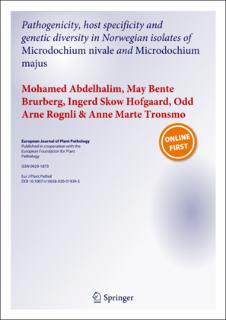| dc.contributor.author | Abdelhalim, Mohamed Ibrahim Mohamed | |
| dc.contributor.author | Brurberg, May Bente | |
| dc.contributor.author | Hofgaard, Ingerd Skow | |
| dc.contributor.author | Rognli, Odd Arne | |
| dc.contributor.author | Tronsmo, Anne Marte | |
| dc.date.accessioned | 2021-05-07T07:05:39Z | |
| dc.date.available | 2021-05-07T07:05:39Z | |
| dc.date.created | 2020-04-06T20:49:53Z | |
| dc.date.issued | 2020 | |
| dc.identifier.citation | European journal of plant pathology. 2020, 156 (3), 885-895. | en_US |
| dc.identifier.issn | 0929-1873 | |
| dc.identifier.uri | https://hdl.handle.net/11250/2754047 | |
| dc.description.abstract | Microdochium majus and Microdochium nivale cause serious disease problems in grasses and cereal crops in the temperate regions. Both fungi can infect the plants during winter (causing pink snow mould) as well as under cool humid conditions during spring and fall. We conducted a pathogenicity test of 15 M. nivale isolates and two M. majus isolates from Norway at low temperature on four different grass cultivars of Lolium perenne and Festulolium hybrids. Significant differences between M. nivale isolates in the ability to cause pink snow mould were detected. The M. nivale strains originally isolated from grasses were more pathogenic than isolates from cereals. The genetic diversity of M. nivale and M. majus isolates was studied by sequencing four genetic regions; Elongation factor-1 alpha (EF-1α), β-tubulin, RNA polymerase II (RPB2) and the Internal Transcribed Spacer (ITS). Phylogenetic trees based on the sequences of these four genetic regions resolved M. nivale and M. majus isolates into separate clades. Higher genetic diversity was found among M. nivale isolates than among M. majus isolates. M. nivale isolates revealed genetic differences related to different host plants (grasses vs. cereals) and different geographic regions (Norway and UK vs. North America). Sequence results from the RPB2 and β-tubulin genes were more informative than those from ITS and EF-1α. The genetic and phenotypic differences detected between Norwegian M. nivale isolates from cereals and grasses support the assumption that host specialization exist within M. nivale isolates. | en_US |
| dc.language.iso | eng | en_US |
| dc.rights | Navngivelse 4.0 Internasjonal | * |
| dc.rights.uri | http://creativecommons.org/licenses/by/4.0/deed.no | * |
| dc.title | Pathogenicity, host specificity and genetic diversity in Norwegian isolates of Microdochium nivale and Microdochium majus | en_US |
| dc.type | Peer reviewed | en_US |
| dc.type | Journal article | en_US |
| dc.description.version | publishedVersion | en_US |
| dc.source.pagenumber | 885-895 | en_US |
| dc.source.volume | 156 | en_US |
| dc.source.journal | European journal of plant pathology | en_US |
| dc.source.issue | 3 | en_US |
| dc.identifier.doi | 10.1007/s10658-020-01939-5 | |
| dc.identifier.cristin | 1805484 | |
| dc.relation.project | Norges forskningsråd: 199664) | en_US |
| dc.relation.project | Norges forskningsråd: 199664 | en_US |
| cristin.ispublished | true | |
| cristin.fulltext | original | |
| cristin.qualitycode | 1 | |

